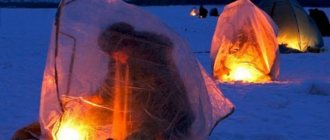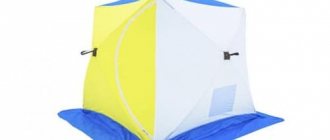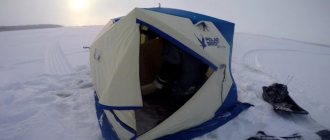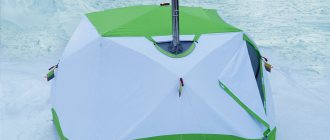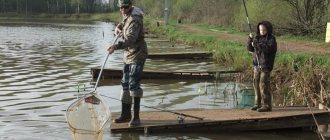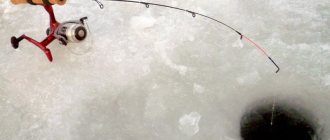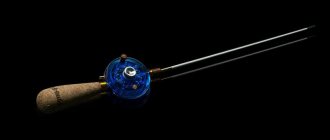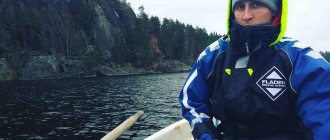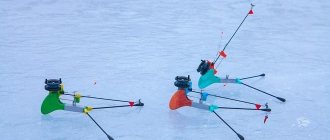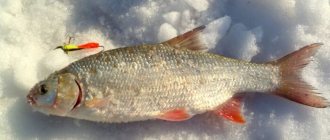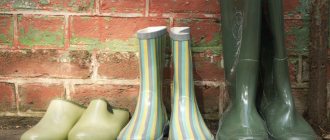Winter fishing is a passionate hobby that captivates you immediately and forever. Once they fall in love with this type of leisure, fishermen remain faithful to it, despite the cold and the dangers that lie in wait for this difficult activity.
Experienced fishermen experience incomparable pleasure from winter fishing, receiving, in addition to the excitement of hunting and the joy of catch, quiet unity with nature and relaxation in the fresh air.
It is a mistake to think that these “unfortunate” people, when exposed to cold, windswept ice for a long time, freeze “to the bone.”

Nowadays, a huge number of ways have been invented to keep warm even in conditions of complete immobility. These are thermal underwear, special shoes and overalls with special impregnation that do not give the slightest chance to cold air, and in case of very severe frosts and bad weather, fishing enthusiasts set up tents for winter fishing, many of which are made with their own hands.

What should a tent be like?
Making such a shelter yourself does not require effort, although it protects from adverse weather conditions no worse, and sometimes better than a purchased one, while saving money.
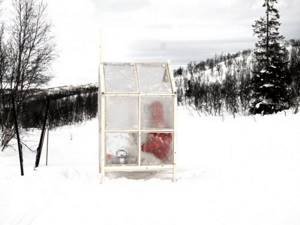
In the manufacture of such structures, the craftsman’s own requirements for the size and weight of the product, the speed of its assembly, the ability to protect from cold, the possibility of insulation and the installation of additional equipment are taken into account.
To retain heat, therefore, to cover it, use a material that has good strength, thermal insulation, moisture resistance, but at the same time has breathable properties.
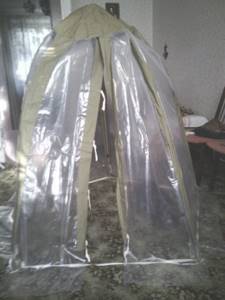
Be lightweight, mobile, compactly folded, and quickly installed. Frames made of aluminum or composite materials meet these requirements.
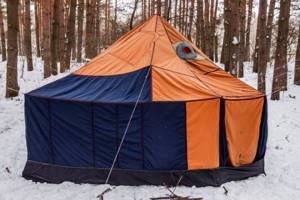
Types of tents
When going camping, pay special attention to the choice of tent. Depending on the type of tent, they may differ in purpose, design, installation features and level of comfort during an overnight stay. In this case, the tourist must take into account all the nuances. So, tents are classified according to the following criteria.
By purpose:
Tracking.
Small products designed for light and short hikes.
This is the best option if you are planning a hiking route through the forest, on flat terrain, or near proven trails of other tourists. Hiking tent SCOUT 2 TRT-55 Tramp 7,900 for 1 piece.
-20%
Tent with vestibule GROT-B 4 V2 TRT-37 Tramp 15,700 12,560 for 1 piece. Tent Trump Arten (T0482) BTrace 1,890 for 1 piece. Trekking tent Pamir 3 RockLand 8,950 for 1 piece. Tourist 4-person tent LAIR 4 TRT-40 Tramp 12,100 per 1 piece. Tourist tent SCOUT 3 TRT-56 Tramp 8,600 per 1 piece. Tent Scout T0201 BTrace 4,500 for 1 piece. Trekking tent BICYCLE LIGHT 1 V2 TRT-33 Tramp 5,400 for 1 piece. Three-person tent LAIR 3 V2 TRT-39 Tramp 11,200 for 1 piece. Tourist tent Vero 3 Green Glade 3 020 for 1 piece. Tent Canio 3 T0232 BTrace 6,200 for 1 piece. 2-person tent L-3003 CAMPACK-TENT 10,550 for 1 piece. Tent with vestibule Zoro 4 Green Glade 6,000 per 1 piece. Tent Peak 2 RockLand 6,250 for 1 piece. Hiking tent Pamir 2 RockLand 7,680 for 1 piece. 2-person tent L-4001 CAMPACK-TENT 9,600 for 1 piece. Trekking tent TOWER 3 Plus (9126.3901) ALEXIKA 29,999 for 1 piece. Trekking tent NAKRA 2 (9124.2101) ALEXIKA 25,199 for 1 piece. 2-person tent L-5001 CAMPACK-TENT 11,700 for 1 piece. Trekking tent NAKRA 3 green ALEXIKA 26,999 for 1 piece. Trekking tent TOWER 4 Plus (9126.4901) ALEXIKA 31,399 for 1 piece. Trekking tent SCOUT 2 (9121.2101) ALEXIKA 18,999 for 1 piece. Trekking tent SCOUT 3 (9121.3101) ALEXIKA 21,699 for 1 piece.
Assault.
Recommended for difficult hikes, including mountainous terrain. They are easy to assemble and disassemble, they are light, reliable and spacious. The only drawback is the high price.
Expeditionary.
This is an advanced version of trekking tents. Features improved protection from wind and water. They are versatile and suitable if you are planning any hike in the mountains, forest or plain.
Camping.
The preferred option for tourists who prefer long trips and vacations in one place for three to four days.
They are distinguished by good spaciousness, comfort, the presence of comfortable hallways and the presence of thoughtful ventilation. The only deterrents are the weight and high cost. Four-person tent BORNEO-4-G green Premier Fishing 12,125 for 1 piece.
Camping tent BORA-6 Helios 21,135 for 1 piece. Camping tent CHALE-4 Premier Fishing 19,390 for 1 piece. High tent BORNEO-6 Premier Fishing 15,205 for 1 piece. Tent tent Rest (T0466) BTrace 7,800 for 1 piece. 6-person tent BORNEO-6-G green Premier Fishing 15,515 for 1 piece. Family tent TYPHOON-3 (HS-2450-3) Helios 14,895 for 1 piece. Two-room tent BREST 4 TRT-82 Tramp 20,500 for 1 piece. All-season tent Multidom 4 Season M-KM-T077 Maverick 41,310 for 1 piece. Tent Ruswell 4 (T0263) BTrace 18,500 for 1 piece. Camping tent SPHINX TRT-88 Tramp 17,500 for 1 piece. Two-room tent BREST 6 TRT-83 Tramp 21,900 for 1 piece. Tent Dome 4 (T0300) BTrace 14,100 per 1 piece. Tent Sunrise 4 GreenLand 12,000 per 1 piece. All-season tent automatic 4 Season Thermal (M-KM-077) Maverick 45,220 for 1 piece. Family tent BELL 3 V2 TRT-80 Tramp 12,700 for 1 piece. Camping tent BELL 4 TRT-81 Tramp 14,200 for 1 piece. Tent ANCHOR 4 (SLT-032.06) SOL 13,500 for 1 piece. Camping tent Weekend 2+2 GreenLand 14,000 for 1 piece. Camping tent Camper 5 RockLand 20,800 per 1 piece. Two-room tent Family 2+2 RockLand 23,250 for 1 piece. Two-room tent Family 3+3 RockLand RockLand 26,000 for 1 piece. Camping tent Indiana M-TC-055 Maverick 25,320 for 1 piece. Camping tent Galaxy M-BBT-56 Maverick 29,280 for 1 piece. Automatic tent Tourer 400 M-KM-093 Maverick 58,030 for 1 pc. Tent Gemini (T0487) BTrace 9,800 for 1 piece. Tent Cape 4 GreenLand for 1 pc. Tent with vestibule VICTORIA 5 LUXE (9155.5301) ALEXIKA 55,799 for 1 piece. Two-room tent VICTORIA 10 (9156.0301) ALEXIKA 58,599 for 1 piece. Camping tent Nomad 4+1 RockLand RockLand 21,700 for 1 piece. Tourist tent Elf 2 Greenell 6,501 for 1 piece. Tent with vestibule Laguna 4+ RockLand 19,600 for 1 piece. Tent Birdland Arten (T0488) BTrace 7,100 for 1 piece. Tent Elf 2 V3 Greenell 6,049 for 1 piece. Automatic tent Grand Family M-TW-095 Maverick 43,820 for 1 piece. Tourist tent Elf 3 V3 Greenell 7,139 for 1 piece. Tent NEVADA 4 green ALEXIKA 40,399 for 1 piece. Tent MINNESOTA 3 LUXE (9153.3401) ALEXIKA 33,999 for 1 piece. Tent EAGLE TRT-064.04 Tramp 19,900 for 1 piece. Special purpose.
This category includes overnight accommodations for fishermen, military personnel, children, winter tourist outings, etc. They are selected individually, taking into account the situation.
By shape and design:
Half barrel.
Externally it looks like a barrel cut lengthwise and in half. This design provides optimal capacity; if properly stretched, a high-quality half-barrel will withstand very strong winds. For fastening, arcs are used, which are installed in parallel and must be additionally secured with spacers.
Hemisphere.
This form is suitable for both simple and complex forays. Pros: ease of installation, stability. Fixation is carried out through several arcs crossed with each other.
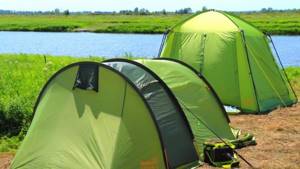
Gable type.
This type of tent was popular during the Soviet era. Outwardly, it resembles a small house, has an affordable price, is lightweight and very compact. But travelers don't like it because of installation problems, poor wind resistance and difficulty finding a place to mount.
By number of layers:
One.
The design of such a tent implies the presence of one layer of material. This option is suitable if you are planning a long hike in difficult conditions, when you need to reduce the total weight of your things and quickly set up a camp in difficult conditions. The downside is poor ventilation, which is especially important for budget products. Travel stores are trying to supply new models of such tents with additional ventilation windows and special membrane fabric.
Two.
Today, almost no professional tourist trip is complete without a double-layer tent. It has a high level of comfort thanks to its two layers. The first reliably protects from natural phenomena, and the second allows clean air to pass through and eliminates the accumulation of condensation. Such structures have windows for ventilation.
By seasonality:
For summer.
They are used when a tourist is planning a hike in good weather conditions. Use in low temperatures, windy or stormy weather is not recommended. Pros: accessibility, small size, optimal ventilation.
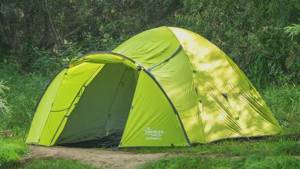
For three seasons.
Such awnings are designed for all seasons of the year, except winter. Protects in cool weather, saves from rain and wind.
All-season.
Awning manufacturers try to supply universal products suitable for all seasons and year-round use. They are resistant to all the whims of nature and even have special “skirts” to retain heat, protect from snow, wind, debris, etc.
To choose the right tent, it is important to focus on many criteria: time of year, number of places, duration of rest, weather, etc. In each case, the decision is made individually.
Making your own tent
When deciding how to make a tent with your own hands, there is no need to be afraid that special knowledge or skills will be required.
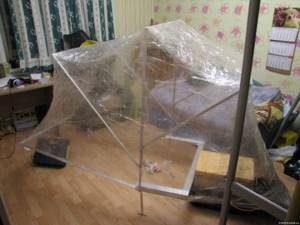
Frame assembly
To make the frame, metal tubes or even ski poles are used as supports. They are connected using fastening hinges and installed directly on skis or other available materials.
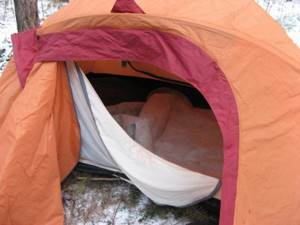
Note!
- A nod for do-it-yourself winter fishing - how and what to make good gear from. 115 photos and video tips from the pros!
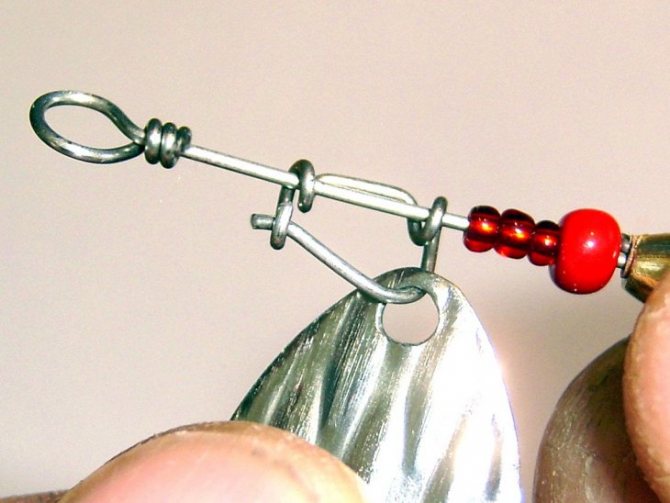
Do-it-yourself spinners - types, features of homemade spinners and their assembly (100 photos and videos)
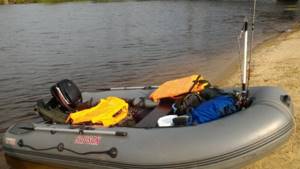
How to minimize fishing costs? Useful tips from experienced fishermen and an overview of current solutions (65 photos)
Choosing a tent by the number of layers
When choosing a shelter based on the number of layers, you should pay attention not to their quantity, but to the quality of the material. Even a single-layer version can be better than a three-layer version if it uses good, waterproof fabric.
Single layer winter tents
It is worth looking at the water resistance of the awning; not all single-layer samples can withstand heavy rain or snow and will allow moisture to pass through.
At the same time, a dense, waterproof awning is not breathable enough, and it will be difficult for two or three people to breathe.
Pros:
- Budget.
-A light weight. Suitable for hiking.
Double-layer winter houses with wind protection and thermal insulation
Such houses consist of an external wind and moisture-proof awning and an internal “breathable” layer.
Due to this design, an air gap is formed between the layers, which serves as free insulation.
Pros:
-Due to the internal “breathable” layer, condensation does not occur
-Wind resistant
Minuses:
-Large weight. Such shelters can be heavier than their three-layer counterparts.
Three-layer tents for winter
They weigh less than double-layer ones. Most often they are made of synthetic fabrics that are not subject to rotting. They have excellent resistance to wind loads and condensation does not form on the walls.
These are universal models for fishing and living. These types are also used as a mobile camp sauna.
Thanks to 3 layers of insulation, the tent heats up quickly and retains heat longer.
Of the minuses:
-They may not have sufficient moisture protection; you must additionally purchase a rain awning.
Manufacturing of coating
In order not to make a mistake with the size of the awning, a drawing with preliminary calculations is first made. On its basis, a pattern is created from the desired fabric.
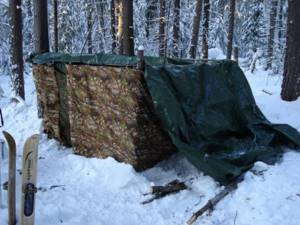
Be sure to add at least two centimeters for seam allowance. To avoid sagging, the dome is secured with eyelets, reinforced if necessary with reinforced tape.
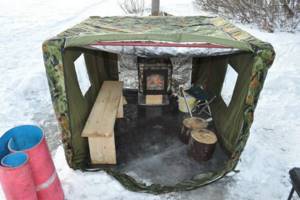
Creating Fasteners
To fix the shelter on the ice, screws are usually used, which you can make yourself using metal rods and self-tapping screws.
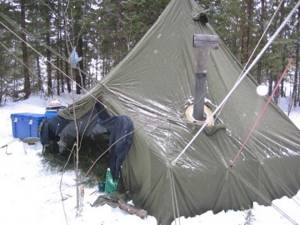
Using hooks or pegs driven into the ice as fasteners is also acceptable, but not very convenient.
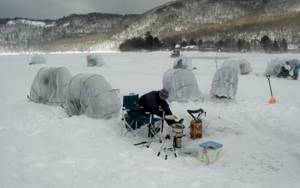
Tent "CUBE"

These tents appeared on our market at reasonable prices relatively recently, but have already managed to win the hearts of fishermen. The tent is great for night fishing. The tent is a cube with convex walls.
Pros: — Rational distribution of space inside the tent due to convex walls. — Relatively high ceilings. Some models allow the fisherman to stand up to his full height. — Possibility to drill holes directly in the tent after installation. — Resistant to wind thanks to a rigid frame.
Cons: - This type of tent is the most expensive on the market. — Due to its large size and shape, the scarf can be torn off by the wind. It is necessary to provide the necessary measures to fix it on the ice. — The method of assembling and attaching the tent to the ice does not imply mobility. The tent is set in place for the entire fishing period. Although there are ways to move it when assembled, these are already sophisticated.
Floor construction
To create more comfortable conditions, you can build a floor for a winter tent with your own hands. This simple work will ultimately help reduce heat loss and, as a result, save on heating the structure.
Note!
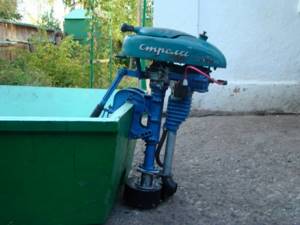
Do-it-yourself boat motor - tips for beginners, projects, drawings and step-by-step description of the construction of the main components and elements (video + 120 photos)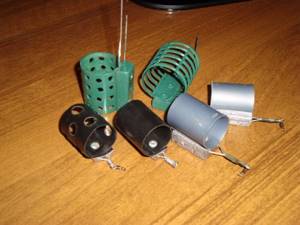
Feeder for winter fishing - secrets of use and techniques for feeding fish in winter (115 photos)

Bottom gear - the most effective types of equipment and features of casting techniques (95 photos and videos)
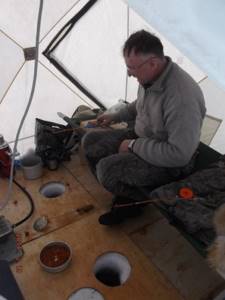
The material for making the floor can be any thick insulation, for example, isolon. When using foil insulation, it is folded in half with the foil facing out, which allows you to retain heat for a longer time and avoid melting ice when using heating appliances.
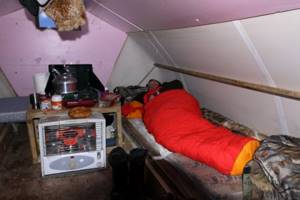
Assembly options
All tents can be divided into two types. These are tents with an automatic unfolding mechanism and classic manually assembled tents.
Automatic tents. Tents that have in their design devices for automatically opening the canopy and holding it in working position. An example is two common types - “springs” and “umbrellas”. When installing automatic tents, a minimum of time is spent, which is their main advantage over classic winter tents with manual assembly. Moving from place to place also does not become a particular problem. The tents can be easily rolled up to the point where they can be transported.
Hand assembled tents. These are frame models of tents with arcs that can be placed both on the outside, forming an external frame, and on the inside. These tents take more time to set up and assemble than their automatic competitors.
Tent heating
The main requirement for heating devices is low fire hazard and no waste.
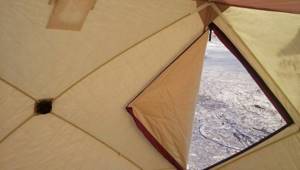
In this case, you can use special industrial devices: gas burners or mobile mini-ovens, or you can heat a winter tent with your own hands using scrap materials.
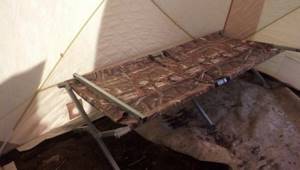
This is done using:
Hot water in a large closed container, covered with a thick cloth to enhance the effect. Its action lasts for several hours.
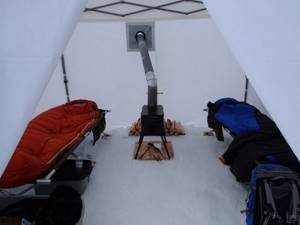
Tourist candles. With low heating efficiency, even one candle can increase the temperature inside a small shelter by several degrees.
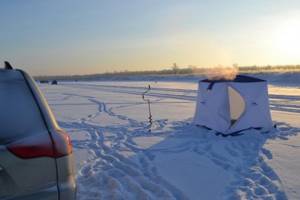
However, fire safety is required here; for this, candles are placed inside cans or other objects that insulate from fire.
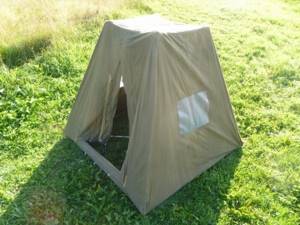
Hot stones or hot sand. To reduce the rate of heat loss, a large stone is wrapped in foil and placed on an insulating base. For the same purposes, but without foil, small stones or sand are used.

The considered methods heat the tent in mild frosts and for a short time.
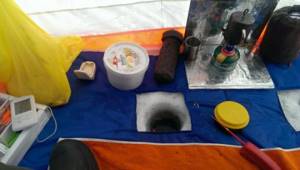
In conditions of severe frosts and many days of staying on ice for a winter tent, it is better to build a stove with your own hands, which will provide long-term heating of the structure and prevent freezing of the holes located inside.
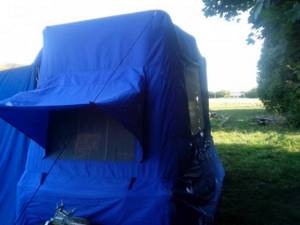
Assembling the Tent: Important Points
Proper tent assembly includes: the steepness of the side surfaces, height and area. The concept of comfort also includes color and base (bottom).
As for the bottom in winter tents. There are 2 theories available. The first is that the bottom of the tent is not necessary, and it only adds inconvenience in the form of icing and thereby weighing down all the things inside.
Table of contents
— What should a winter tent be like? ↓ — What should a summer tent be like? ↓ — Presentation of LOTOS winter tents on Video ↓
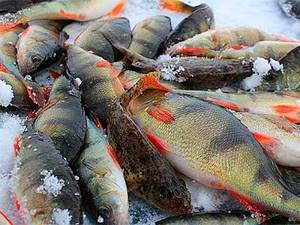
237 kilograms of fish from one hole!
The detained fishermen told the secret of a good bite. The fishery inspectors were surprised by the lack of prohibited equipment...
Read more
The second is the opposite, that the bottom is necessary to absorb moisture and thereby keep things dry. They also argue for this position with easy assembly.
But this position does not seem entirely justified. Because the bottom is still necessary and you can make it yourself. A simple waterproof fabric that is highly breathable is sufficient.
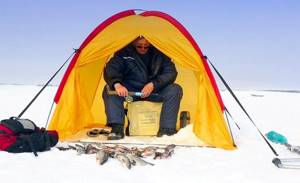
Furnace for winter shelter
Any beginner can create homemade stoves with a wide variety of shapes and sizes.
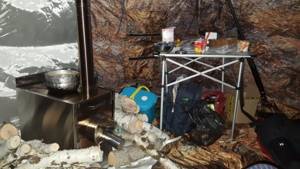
The most primitive and popular design is made from an ordinary tin can and is not inferior in functionality to industrially produced models.

To make it, in addition to the jar, you will need:
- a metal mug, the diameter of which is 1 cm less than the diameter of the jar;
- spare parts from an old TV antenna;
- fastening material;
- a piece of tin sheet.
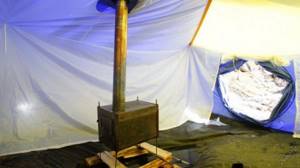
Having collected the necessary parts, you can begin assembly:
A circle with a diameter of 3 cm is cut out of a tin sheet. It is divided into three segments, bent at an angle of 90 degrees, forming petals.
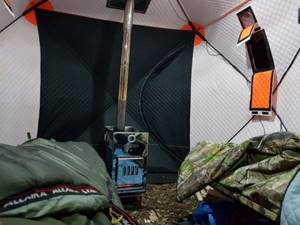
Regarding the position of the petals, three holes are made in the bottom of the jar, matching in size with the tips of the petals.
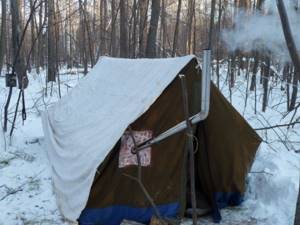
The circle is fixed on the bottom of the jar due to the petals that fall into the corresponding grooves. Its surface is intended for fuel.
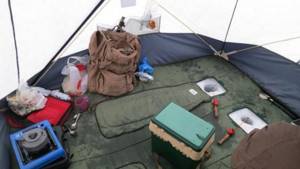
At a distance of 2-2.5 cm from the top edge of the jar, three holes are drilled for the nuts on which the mug is secured.
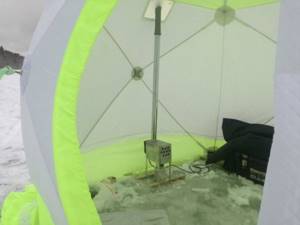
Slots are made in the bottom of the structure for legs made from parts of an old antenna; their size should not exceed the diameter of the mug.

For the lid of the structure, you can use another tin can, cut appropriately and tightly fitting to the top of the stove.
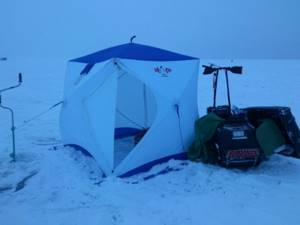
Several more holes are scrolled along the entire bottom of the product, located at an equal distance from each other.
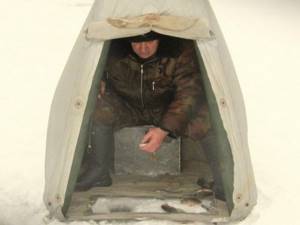
Such a device, despite its unpresentable appearance, does an excellent job of heating a tent, and with a little improvement, heating food.
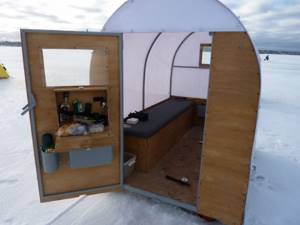
A tent is an indispensable thing for winter fishing
When planning winter fishing, it is necessary to provide for many situations in which lovers of this extreme recreation may find themselves.
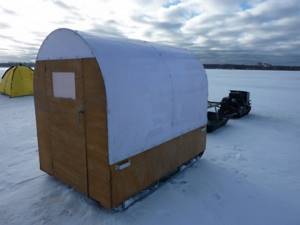
A self-made tent, as well as equipping it with necessary household items, will take into account all the individual needs of the creator, and thereby not only preserve his health, but also provide the necessary comfort and safety in difficult weather conditions.
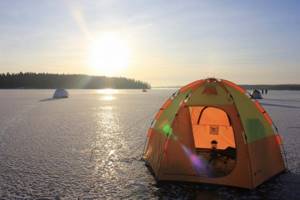
DIY winter tent photo
Read here Summer girder: a step-by-step description of how to make it yourself and how to catch fish with it (105 photos)
Help the project, share on social networks 

0
